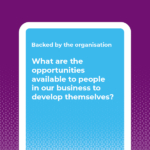What we’ve learnt about careers: Adapting your approach to your organisational context
At Let’s Talk Talent, the question we hear most from people we coach, regardless of the organisation they work for, always remains the same: “How can I develop my career?”
It would seem that despite their best efforts, helping employees progress with their career is something most businesses struggle with, no matter their size or the industry they operate in. But finding ways to help ambitious talent move towards the next stage of their careers is essential, and even more so now that the pandemic has led to employees rethinking their priorities and taking action to ensure they feel more fulfilled, challenged and motivated at work. Which has made attracting and retaining people even more difficult than before for businesses everywhere.
We all know that one of the best ways to both appeal to potential candidates and keep existing staff is to provide great opportunities for career progression. But this continues to prove tricky in a skills market in constant motion.
How can companies answer the big career development question considering there are so many moving parts? There is of course no single answer to this conundrum, but there are a few different ways to approach the challenge.
Below are two opposite perspectives, from very different organisations, each facing the same challenge: supporting their staff’s career development in the most effective way.
Company A: a quick introduction
Despite being a long-established financial sector, Company A has a very modern approach, with a flat structure and a dynamic internal culture. This represents a shift from the other players in the industry; a strong draw for talent.
Company A is indeed a great place to work. Which is fantastic, of course!
However, being one of the most attractive workplaces in a sea of old-fashioned options also has a downside when it comes to career development. Employees (understandably) tend to remain within the organisation for longer periods of time, which leads to fewer opportunities for linear, hierarchical career progression.
Where can staff go next when the seat above is likely to be occupied for years to come?
How Company A handled career progression
The HR department’s priority was to design new creative ways for people to explore career progression. The goal was to give staff the opportunity to grow and develop beyond the obvious upwards choices. Company A also understood that it’s down to each individual to carve their own career path. Kind of like a Choose Your Own Adventure Book, with readers being given several options, but always remaining in charge of next steps.
To support its people, Company A did invest a lot of time and resources in creating development opportunities such as training, internal mobility options, coaching, networking and mentoring. However, this quickly became overwhelming for people looking for a clear path in a sea of possibilities. Guidance was required, which is why LTT held workshops to establish broad career motivation categories and designed toolkits aimed at pointing people towards the tools, resources and exercise that would be most relevant for their particular situation.
Company B: a quick introduction
Company B could not be more different. Operating in the technology sector, it has a hard time holding on to talent as employees are relentlessly courted by competitors with offers of high salaries and amazing benefits.
Like Company A, it is a global organisation, made up of several smaller businesses brought together by mergers and acquisitions. This has resulted in very different cultures and processes throughout the various business units when it comes to career progression.
How Company B handled career progression
With a very entrepreneurial focus on driving business growth, there is little focus left for implementing global career progression policies and guidelines. This means that development opportunities are handled on an individual basis, with many variations visible from one area to the next. Career frameworks are available within some business units, but not all. Whilst this could sound like a negative, it also means that the discretionary approach adopted by the organisation takes into account each unit and its internal culture rather than implementing blanket policies, which may not work on a local level.
Career discussions, tools and growth opportunities are explored between employees and managers, without a one-size-fits-all cookie cutter guide to career progression. Some employees undoubtedly benefit from personalised guidance and support, but this approach also makes it difficult to ensure a consistent employee experience for all staff as some are operating under busy managers with ambitious growth targets, and less time available to help them achieve their ambitions.
The common career development problems
What the above shows us goes beyond simply illustrating two different options available to support staff with their career development. Working with those two clients, we could quickly see that despite their very different organisational contexts, the same underlying issues remain for both companies, and indeed for most businesses.
- Fairness and inclusivity: Transparently applying consistent criteria for progression, promotion, pay and reward is key to keeping people motivated and striving for more.
- Reliance on line managers: Managers are the ones delivering and implementing your career strategy. They are on the front line, but their focus is often elsewhere. They are tasked with driving business growth and managing operations, team performance, processes, admin and have little time left to help others develop.
- Global vs local: Consistency across the board is crucial. But most organisations have business units in different industries, areas, and even different continents. Designing and implementing global policies can be hard to achieve.
- Ownership of career development: Most of the ownership for your people’s career development sits squarely on each individual’s shoulders. But managers and the organisation as a whole also have a role to play. Finding the right balance for your business can sometimes be tricky.
What we’ve seen work
With so many issues, some of them difficult to overcome, what should businesses do? We have a simple answer, no matter your size, sector, level of maturity and internal culture: empower your people. Putting the onus on the individual allows your talent pool to embrace a career path that truly fits their needs. Your focus should therefore be on giving them the tools they require to achieve the goals they set for themselves and enough guidance to know where to start. From career toolkits to ‘stay’ conversations with managers, and everything in between, find what works for your people so they can elevate themselves to the next level.
Conclusion
Each company is different, and your approach to careers will differ. What matters is that you serve your talent.
Both of the companies mentioned above are great examples we can all learn from.
A talent pool that enjoys their workplace and wants to carve out a fulfilling career for themselves, coupled with a clear desire to support employees in their professional journey. It’s been proven that for staff, the opportunity to develop their careers is an important motivational drivers, and focusing your efforts on enabling your people’s ambitions in an employee’s market can only benefit your talent strategy. Despite the challenges you face as an organisation, there is one universal key to success: giving your people the tools they need to take charge of their own professional goals.
Do you agree? Is your experience any different? Have you encountered other issues that we didn’t mention? Get in touch, we’d love to hear from you.




